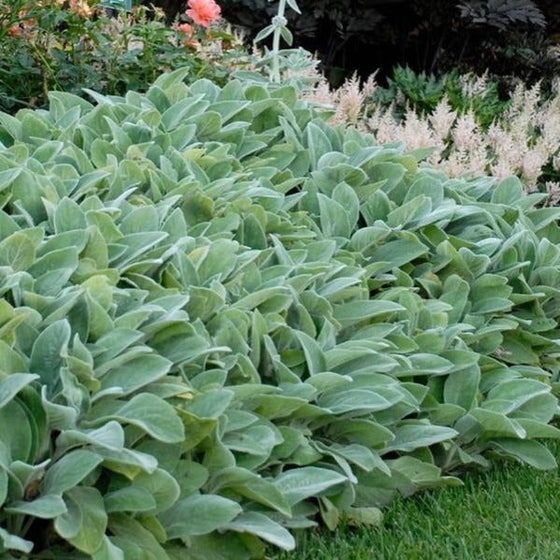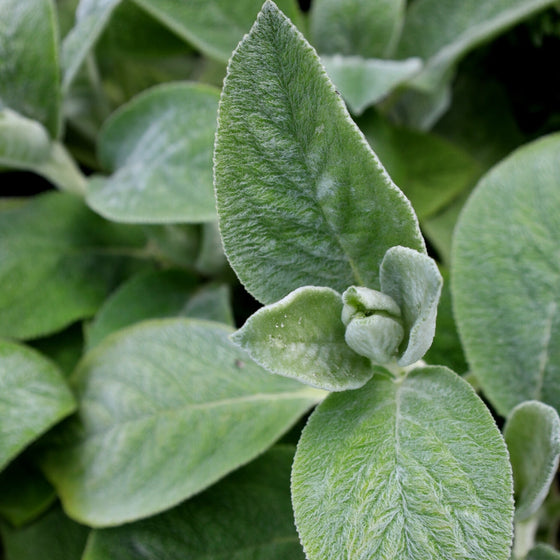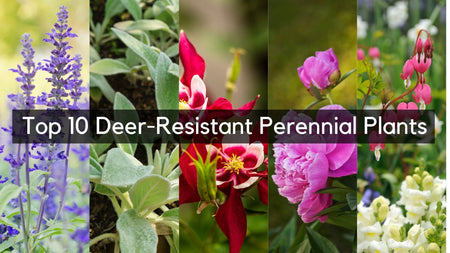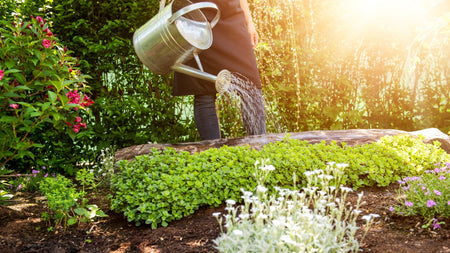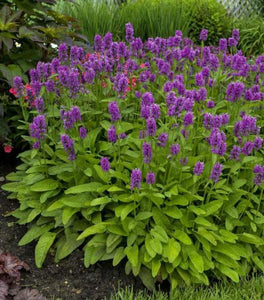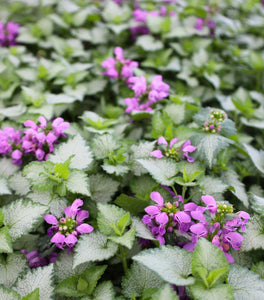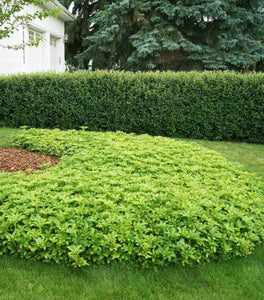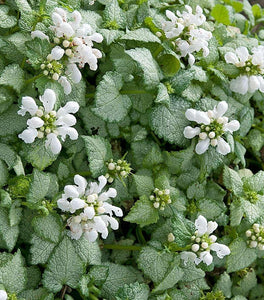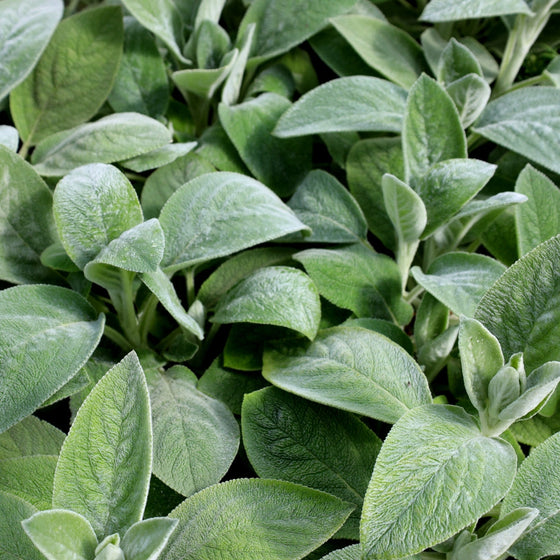
Images Depict Mature Plants
Lambs Ear Plants for Sale Online
Lamb's Ear (Stachys byzantina 'Big Ears') is a hardy, low-growing perennial beloved for its soft, velvety, silver-green foliage that resembles the texture of a lamb's Ear. Growing up to 12-18 inches tall and spreading up to 24 inches wide, this plant is perfect for adding a unique texture and contrast to garden beds, borders, or pathways. Its dense, mat-forming habit makes it an excellent groundcover, and its fuzzy leaves create a striking visual effect when paired with other flowering perennials. Lamb's Ear also works well in container gardens, adding softness and a pop of silvery-green color to mixed arrangements.
Hardy in USDA Zones 4-9, Lamb's Ear thrives in full sun and well-drained soil, making it an excellent option for xeriscaping or gardens in drier climates. This drought-tolerant perennial is extremely low-maintenance and adapts well to poor soil conditions, which makes it an ideal choice for rock gardens or areas with less-than-ideal soil. In late spring to early summer, Lamb's Ear may produce small spikes of purple or pink flowers, adding an extra layer of interest to this otherwise foliage-focused plant. However, many gardeners prefer to trim the flower spikes to maintain the neat, compact appearance of the plant.
In addition to its decorative appeal, Lamb's Ear is deer-resistant and ideal for gardens where wildlife browsing is a concern. Its dense, fuzzy leaves add texture and color and help suppress weeds, making it a practical and attractive ground cover. Whether used in borders, mass plantings, or as edging along pathways, Lamb's Ear brings beauty and functionality to any landscape, offering year-round interest and ease of care for gardeners of all experience levels.

| Hardiness Zone: | 4-9 |
|---|---|
| Mature Height: | Up to 1 foot |
| Mature Width: | 1 to 2 Feet |
| Sunlight: | Full sun |
| Water Requirements: | Water well only until established |
How to Care for Lambs Ear
Be sure to read our planting instructions to ensure a healthy and happy Stachys Big Ears for years to come!
How Do I Plant Lamb's Ear Plant?
To plant Lamb's Ear (Stachys byzantina 'Big Ears'), start by selecting a location with full sun to partial shade and well-drained soil. This drought-tolerant plant thrives in sunny areas, but it can also handle light shade, particularly in hot climates. Prepare the soil by loosening it and mixing in organic matter if the soil is too heavy or clay-like, as Lamb's Ear does not tolerate waterlogged conditions. Dig a hole slightly larger than the root ball, and place the plant so that the crown is level with the surrounding soil. After backfilling the hole, water thoroughly to help the plant settle, but be careful not to overwater, as Lamb's Ear prefers dry to moderately moist soil. When planting Lamb's Ear in groups or as a groundcover, space the plants 12-18 inches apart to allow for their spreading habit. This plant grows best when given room to form its dense, mat-like foliage. Once established, Lamb's Ear requires minimal maintenance, and its fuzzy, silver-green leaves will add texture and contrast to your garden beds, borders, or rock gardens. Mulching around the plant can help retain moisture and suppress weeds, but be sure to leave some space around the crown to prevent rot. With proper planting and care, Lamb's Ear will thrive and provide both beauty and functionality as a low-maintenance, drought-tolerant plant.
How Do I Water Lamb's Ear Plant?
To water Lamb's Ear (Stachys 'Big Ears'), it’s important to keep in mind that this drought-tolerant plant prefers dry to moderately moist soil. After planting, water thoroughly to help establish its roots, but avoid overwatering as Lamb’s Ear is highly susceptible to root rot in waterlogged conditions. Once established, this plant requires minimal watering, thriving in dry conditions typical of rock gardens, borders, and xeriscaping. During periods of extended drought or extreme heat, a deep watering once every couple of weeks will help the plant stay healthy without oversaturating the soil. When watering Lamb's Ear, it’s best to water the base of the plant directly, avoiding the fuzzy leaves, as excess moisture on the foliage can lead to mildew or fungal diseases. If the plant is in a container, ensure proper drainage to prevent water from accumulating at the roots. In wetter climates, it’s important to monitor the soil and only water when the top inch feels dry. This low-maintenance plant prefers well-drained soil and minimal water, making it an excellent choice for sunny, dry garden areas where other plants may struggle.
How Do I Fertilize Lamb's Ear Plant?
To fertilize Lamb's Ear use a balanced, slow-release fertilizer in early spring to promote healthy growth and maintain its vibrant, silvery-green foliage. A general-purpose 10-10-10 fertilizer works well, providing essential nutrients like nitrogen, phosphorus, and potassium to support overall plant health. Apply the fertilizer sparingly around the base of the plant, avoiding direct contact with the leaves, and water thoroughly afterward to help the nutrients reach the roots. Since Lamb’s Ear thrives in poorer soils, over-fertilization can lead to excessive leaf growth, so it’s best to apply a light hand when feeding this plant. Once established, Lamb's Ear typically requires minimal fertilization, as it is adapted to thrive in low-nutrient conditions. In most cases, a single application of fertilizer in spring is sufficient for the growing season. If your soil is already nutrient-rich, you may not need to fertilize at all, especially if the plant is showing strong, healthy growth. For organic options, compost or well-rotted manure can be added in small amounts to provide a natural nutrient boost. With proper, minimal fertilization, Lamb's Ear will continue to thrive as a low-maintenance, drought-tolerant groundcover or border plant.

How Do I Prune Lamb's Ear Plant?
To prune Lamb's Ear start by removing any dead or damaged leaves in early spring, just before new growth begins. Using clean, sharp scissors or pruning shears, trim away brown, wilted, or damaged foliage at the base of the plant to encourage fresh, healthy growth. This pruning helps maintain the plant's neat appearance and prevents overcrowding, which can lead to moisture buildup and potential fungal issues. Regularly removing dead or unsightly leaves also promotes better air circulation around the plant, keeping the fuzzy, silver-green foliage looking vibrant throughout the growing season. In late summer, after the blooming period, you can deadhead any spent flower spikes to prevent the plant from becoming leggy or untidy. Lamb's Ear produces tall, spike-like flowers, but many gardeners prefer to cut these off to maintain the plant’s compact, foliage-focused form. If the plant becomes too large or overgrown, you can prune back entire sections to keep it within its desired space. For container-grown Lamb’s Ear, regular light pruning is especially helpful to manage size and keep the plant looking fresh. By pruning regularly, you’ll ensure that your Lamb's Ear stays healthy, compact, and attractive in borders, rock gardens, or as a groundcover.

